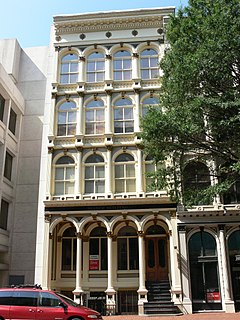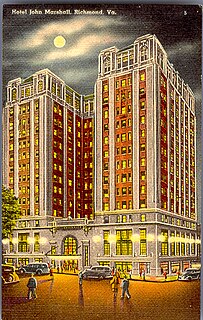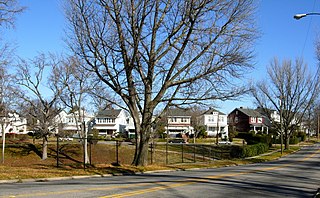
Ginter Park is a suburban neighborhood of Richmond, Virginia built on land owned and developed by Lewis Ginter. The neighborhood's first well known resident was newspaperman Joseph Bryan, who lived in Laburnum, first built in 1883 and later rebuilt. In 1895, many acres of land north of Richmond were purchased by Ginter in order to develop into neighborhoods. Ginter Park and other neighborhoods were developed from this initial land purchase. In Ginter Park are Union Presbyterian Seminary and as well as Pollard Park.

Broad Street Station was a union railroad station in Richmond, Virginia, United States, across Broad Street from the Fan district. The building is now used by the Science Museum of Virginia.

Union Hill is a historic district of Richmond, Virginia. According to the Richmond Times Dispatch, the neighborhood "generally is bordered on the south by East Marshall Street and Jefferson Avenue, on the west by Mosby Street, on the north by O and Carrington streets, and angled on the east by North 25th Street." The neighborhood is on the Virginia Landmarks Register and the National Register of Historic Places, and is also one of sixteen designated "Old and Historic Districts" in Richmond.

This is a list of the National Register of Historic Places listings in Albemarle County, Virginia.

Barton Heights is a streetcar suburb neighborhood and former town in the Northside area of Richmond, Virginia. The area was primarily developed between 1890 and the 1920s.
The West Broad Street Commercial Historic District is a national historic district located at Richmond, Virginia. The district encompasses 20 contributing buildings built between about 1900 and the late 1930s. Located in the district is the Forbes Motor Car Company (1919), Harper-Overland Company building (1921), Firestone Building (1929), Engine Company No. 10 Firehouse, and the Saunders Station Post Office (1937). The majority of the buildings are two-to-four stories in height and are composed of brick with stucco, stone and metal detailing. Located in the district is the separately listed The Coliseum-Duplex Envelope Company Building.

Branch Building, also known as the Virginia Fire and Marine Insurance Company, is a historic commercial building located in Richmond, Virginia. It was built about 1886, and is a four-story, four bay, brick building with a cast iron front. The building measures 26 feet wide by 140 feet deep.
Albert F. Huntt was an architect in Richmond, Virginia. Huntt was born in Richmond in approximately 1868 and his great-grandfather, Otis Manson, was an architect who came to Richmond from New England. He studied at Pennsylvania Military Academy in Chester, Pennsylvania and married Georgiana Bartram Hathaway of Chester after graduation. He died at his home in Richmond on July 14, 1920.

St. Andrew's Church is an historic Episcopal church complex in Richmond, Virginia, United States. The complex consists of the church (1901), school (1901), parish hall (1904), Instructive Nurse Association Building (1904), and William Byrd Community House or Arents Free Library (1908). The church is a rough-faced Virginia granite, cruciform Gothic Revival style structure dominated by a 115-foot corner tower. The school and parish hall are three-story, brick buildings on a stone basements.

E. M. Todd Company, also known as Todd's Ham Building, is a historic factory building located in the Three Corners District of Richmond, Virginia. The original section was built in 1892 and expanded in 1919 and 1920. The expansion included five story smoke houses. It originally housed the Richmond Brewery, and was later acquired by the E. M. Todd Company a manufacturer of smoked ham and bacon. The E. M. Todd Company ceased operations at the plant in 1998.

The Grace Street Commercial Historic District is a national historic district located in Richmond, Virginia. The district encompasses 93 contributing buildings located in downtown Richmond. The buildings reflect the core of the city's early 20th-century retail development and the remnants of a 19th-century residential neighborhood. The buildings are in a variety of popular 19th-century and early 20th-century architectural styles, including Classical Revival, Mission Revival, International Style, and Colonial Revival. Notable buildings include the Administration and Equipment Building for the Chesapeake & Potomac Telephone Company (1929), Thalhimer's Department Store, Atlantic Life Building (1950-1959), Miller & Rhoads Department Store, Berry-Burk Building, former W. W. Foster Studios (1927), Bank of Virginia (1949), Investment Realty Company building (1930), W.T. Grant Store (1939), Hotel John Marshall (1927), Franklin Federal Savings and Loan building (1954), and the Tompkins House (1820). Located in the district and separately listed are the Loew's Theatre, Centenary United Methodist Church, Joseph P. Winston House, Central National Bank, and National Theater.

The Carver Industrial Historic District is a national historic district located at Carver, Richmond, Virginia. The district encompasses 13 contributing buildings located west of downtown Richmond. The industrial area developed between 1890 and 1930, along the tracks of the Richmond, Fredericksburg and Potomac Railroad. The buildings are in a variety of popular 19th-century and early 20th century architectural styles including Queen Anne and Romanesque.

The Carver Residential Historic District is a national historic district located at Carver, Richmond, Virginia. The district encompasses 312 contributing buildings and 1 contributing site located west of downtown Richmond. The primarily residential area developed starting in the mid-19th century. The buildings are in a variety of popular 19th-century and early 20th-century architectural styles, including Gothic Revival and Greek Revival. Notable buildings include the Hardin Davis House (1842), Amanda Ragland House (1843), Reuben Lacy House (1859), Rueben T. Hill House (1900), George Washington Carver Elementary School (1887), Moore Street Baptist Church (1909), Baughman Brothers/Biggs Antique Company building (1924), and the T&E Laundry Company Building.

The Laburnum Park Historic District is a national historic district located at Richmond, Virginia. The district encompasses 226 contributing buildings and 2 contributing structures located north of downtown Richmond. The primarily residential area developed starting in the early-20th century as one of the city's early "streetcar suburbs" and as home to several important local institutions. The buildings are in a variety of popular early-20th century architectural styles including Queen Anne and Colonial Revival. It was developed as neighborhood of middle-to-upper-class, single-family dwellings. Notable buildings include the Laburnum House (1908), Richmond Memorial Hospital (1954-1957), Richmond Memorial Hospital Nursing School (1960-1961), "The Hermitage" (1911), Laburnum Court (1919), Veritas School.

The Brookland Park Historic District is a national historic district located at Richmond, Virginia. The district encompasses 1,157 contributing buildings located north of downtown Richmond and Barton Heights. The primarily residential area developed starting in the late-19th century as one of the city's early “streetcar suburbs.” The buildings are in a variety of popular late-19th and early-20th century architectural styles including frame bungalows and American Foursquare. The neighborhood is characterized by frame dwellings with a single-story porch spanning the facade, and either Colonial Revival or Craftsman in style, moderate in scale, with understated materials and stylistic expression. Notable non-residential buildings include the North Side Branch building, Brookland Inn, former A&P Grocery Store, North Side Junior High School, Barack Obama Elementary School, St. Paul's School building (1923), St. Philip's Episcopal Church, First African Baptist Church (1922), and Garland Avenue Baptist Church.

The Battery Court Historic District is a national historic district located at Richmond, Virginia. The district encompasses 549 contributing buildings and 1 contributing site located north of downtown Richmond and west of Barton Heights and Brookland Park. The primarily residential area developed starting in the early-20th century as one of the city's early “streetcar suburbs.” The buildings are in a variety of popular late-19th and early-20th century architectural styles including frame bungalows, American Foursquare, Colonial Revival, Tudor Revival, and Mission Revival. Notable non-residential buildings include the Overbrook Presbyterian Church and Battery Park Christian Church.

The Scott's Addition Historic District is a national historic district located in Richmond, Virginia.

Southern Biscuit Company, also known as Interbake Foods, Inc. and Famous Foods of Virginia (FFV), is a historic factory building located in Richmond, Virginia. The original section was built in 1927, and is a six-story, reinforced concrete building. It was subsequently expanded four times through 1951. The building features a water tower and distinctive roof-top sign. The sign has three rows of letters spelling "HOME OF", "FFV", and "COOKIES AND CRACKERS". The facility closed in 2006.

The West Broad Street Industrial and Commercial Historic District is a national historic district located at Richmond, Virginia. The district encompasses 29 contributing buildings and 1 contributing object built between 1902 and the 1930s. The District is characterized by a variety of architectural styles, including large industrial vernacular buildings, standard post-1900 commercial storefronts, and a large Modern-style department store. The majority of the buildings are two-to-four stories in height and are composed of brick with stucco, stone and metal detailing. Notable buildings include Putney Shoe Factory (1910), C.F. Sauer Headquarters (1910), L.H. Jenkins Book Manufactory (1902), Virginia School Supply Company (1913), the Coca-Cola Bottling Plant (1925), and the former Sears department store. Located in the district is the separately listed Atlantic Motor Company.

Salem Avenue–Roanoke Automotive Commercial Historic District is a national historic district located of Roanoke, Virginia. It encompasses 59 contributing buildings in the southwestern part of the City of Roanoke. The district includes a variety of buildings having automotive, warehouse, light industrial and residential uses. Most of the buildings are small-scale, one or two-story brick or concrete block buildings, with the majority built between about 1920 and 1954. Notable buildings include the former Enfield Buick Dealership, Lindsay-Robinson & Co. Building (1918), Fulton Motor Company Auto Sales & Service (1928), Lacy Edgerton Motor Company, Roanoke Motor Car Company, and Fire Department No. 3 (1909).






















